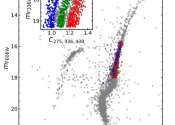DESI first-year data delivers unprecedented measurements of expanding universe
Scientists have analyzed the first batch of data from the Dark Energy Spectroscopic Instrument's quest to map the universe and unravel the mysteries of dark energy.

Scientists have analyzed the first batch of data from the Dark Energy Spectroscopic Instrument's quest to map the universe and unravel the mysteries of dark energy.
Astronomy
Apr 6, 2024
7
583

Researchers have detected complex organic molecules in a galaxy more than 12 billion light-years away from Earth—the most distant galaxy in which these molecules are now known to exist. Thanks to the capabilities of the ...
Astronomy
Jun 5, 2023
14
1909

(Phys.org)—Astronomers using the NASA/ESA Hubble Space Telescope have studied a giant filament of dark matter in 3D for the first time. Extending 60 million light-years from one of the most massive galaxy clusters known, ...
Astronomy
Oct 16, 2012
36
1

(PhysOrg.com) -- Until now, it has stubbornly defied all attempts at detection: according to current textbooks, gas-phase carbonic acid should not exist at all, because it immediately decomposes into water and carbon dioxide ...
Analytical Chemistry
Dec 24, 2010
3
1

Quantum magnets can be studied using high-resolution spectroscopic studies to access magnetodynamic quantities including energy barriers, magnetic interactions, and lifetime of excited states. In a new report now published ...

Star and planet formation is a messy affair. It starts with the gravitational collapse of a gigantic cloud of gas and dust, which simultaneously produces massive stars, whose intense radiation field creates a harsh environment, ...
Astronomy
May 14, 2024
0
87

The NASA/ESA/CSA James Webb Space Telescope will release its first full-color images and spectroscopic data on 12 July 2022.
Astronomy
Jun 1, 2022
1
104

Using the Very Large Telescope (VLT) and the Hubble Space Telescope (HST), astronomers have investigated one of the Milky Way's globular clusters, Messier 80. The new study concentrated on peculiar kinematics of Messier 80's ...

An international team of astronomers has unveiled the nature of hundreds of gamma-ray emitting sources, discovering that most of them belong to the class of active galaxies known as blazars.
Astronomy
Oct 11, 2021
0
1341

NASA's James Webb Space Telescope captured its first images and spectra of Mars Sept. 5. The telescope, an international collaboration with ESA (European Space Agency) and CSA (Canadian Space Agency), provides a unique perspective ...
Planetary Sciences
Sep 19, 2022
0
77